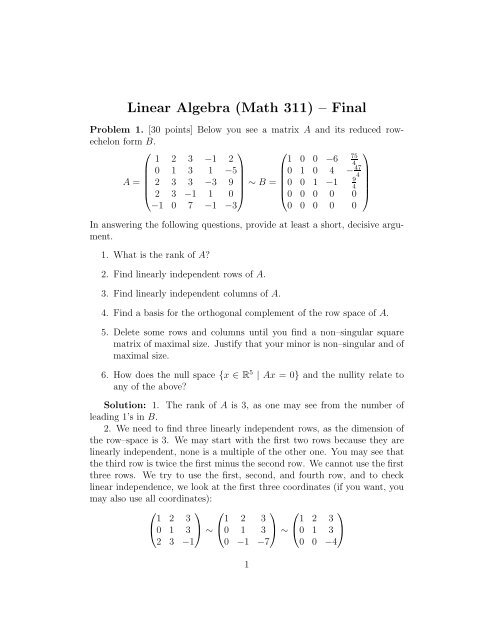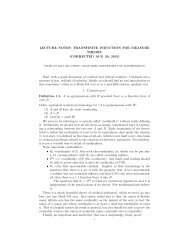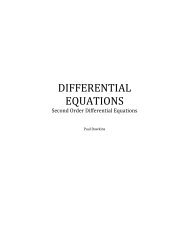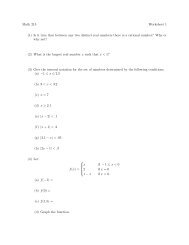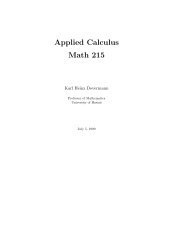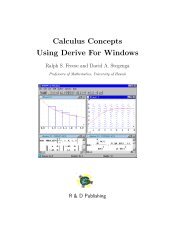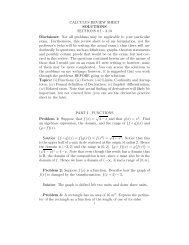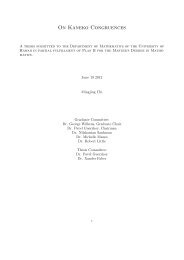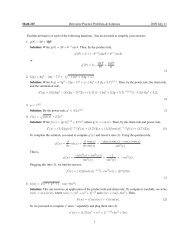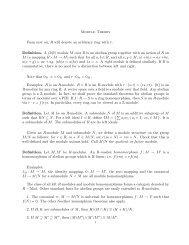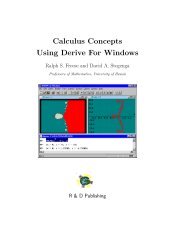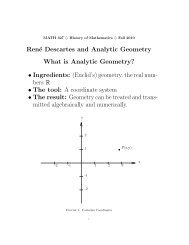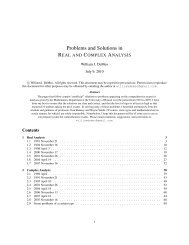You also want an ePaper? Increase the reach of your titles
YUMPU automatically turns print PDFs into web optimized ePapers that Google loves.
<strong>Linear</strong> <strong>Algebra</strong> (<strong>Math</strong> <strong>311</strong>) <strong>–</strong> <strong>Final</strong><br />
Problem 1. [30 points] Below you see a matrix A and its reduced rowechelon<br />
form B.<br />
⎛<br />
1<br />
⎜ 0<br />
A = ⎜ 2<br />
⎝ 2<br />
2 3<br />
1 3<br />
3 3<br />
3 −1<br />
−1<br />
1<br />
−3<br />
1<br />
⎞ ⎛<br />
2 1 0 0 −6<br />
−5⎟<br />
⎜<br />
⎟ ⎜0<br />
1 0 4<br />
9 ⎟ ∼ B = ⎜<br />
0 ⎠ ⎝<br />
75<br />
4<br />
−<br />
−1 0 7 −1 −3<br />
47<br />
0 0 1 −1<br />
0 0 0 0<br />
⎞<br />
⎟<br />
4 ⎟<br />
9 ⎟<br />
4 ⎟<br />
0 ⎠<br />
0 0 0 0 0<br />
In answering the following questions, provide at least a short, decisive argument.<br />
1. What is the rank of A?<br />
2. Find linearly independent rows of A.<br />
3. Find linearly independent columns of A.<br />
4. Find a basis for the orthogonal complement of the row space of A.<br />
5. Delete some rows and columns until you find a non<strong>–</strong>singular square<br />
matrix of maximal size. Justify that your minor is non<strong>–</strong>singular and of<br />
maximal size.<br />
6. How does the null space {x ∈ R 5 | Ax = 0} and the nullity relate to<br />
any of the above?<br />
Solution: 1. The rank of A is 3, as one may see from the number of<br />
leading 1’s in B.<br />
2. We need to find three linearly independent rows, as the dimension of<br />
the row<strong>–</strong>space is 3. We may start with the first two rows because they are<br />
linearly independent, none is a multiple of the other one. You may see that<br />
the third row is twice the first minus the second row. We cannot use the first<br />
three rows. We try to use the first, second, and fourth row, and to check<br />
linear independence, we look at the first three coordinates (if you want, you<br />
may also use all coordinates):<br />
⎛ ⎞ ⎛ ⎞ ⎛ ⎞<br />
1 2 3 1 2 3 1 2 3<br />
⎝0<br />
1 3 ⎠ ∼ ⎝0<br />
1 3 ⎠ ∼ ⎝0<br />
1 3 ⎠<br />
2 3 −1 0 −1 −7 0 0 −4<br />
1
From the last matrix in the computation we see that the matrix is nonsingular,<br />
and we conclude that the first, second, and fourth row are linearly<br />
independent.<br />
3. The first three columns of A are linearly independent because that is<br />
where B has the leading 1’s.<br />
4. The orthogonal complement to the row<strong>–</strong>space is the null space of the<br />
matrix. The last two ccordinates are free. We obtain a basis by setting either<br />
x4 = 1 and x5 = 0 or x4 = 0 and x5 = 1. With these choices we get the basis<br />
⎧⎛<br />
⎞<br />
6<br />
⎪⎨ ⎜<br />
⎜−4<br />
⎟<br />
⎜ 1 ⎟<br />
⎝<br />
⎪⎩<br />
1 ⎠<br />
0<br />
,<br />
⎛ ⎞⎫<br />
−75<br />
⎜ 47 ⎟⎪⎬<br />
⎟<br />
⎜ −9 ⎟<br />
⎝ 0 ⎠<br />
⎪⎭<br />
4<br />
5. We solved part 5. as part 2. of the problem. Delete the last two<br />
columns of the matrix, as well as row three and five. The result is a nonsingular<br />
matrix. There is not larger nonsingular minor, because is size will be<br />
the rank of the matrix, and that is 3.<br />
6. As stated in 4. the nullspace of the matrix is the orthogonal complement<br />
of its rowspace. The nullity is its dimension, and it is the number of<br />
columns minus the rank of the matrix. The nullity is 5 − 3 = 2.<br />
Problem 2. [10 points] Consider the vector space P2 of polynomials of degree<br />
at most 2 with the basis consisting of the vectors v1 = 1, v2 = 1 + t, and<br />
v3 = 1 + t + t 2 . Differentiation defines a linear map D : P2 → P2. Find the<br />
matrix of D with respect to the given basis.<br />
Solution: We apply D to the basis elements, making sure that the results<br />
are given in terms of the basis again. We find: D(v1) = 0, D(v2) = 1 = v1,<br />
and D(v2) = 1 + 2t = −1 + 2(1 + t) = −v1 + 2v2. Accordingly, the matrix<br />
for D is ⎛ ⎞<br />
0 1 −1<br />
⎝0<br />
0 2 ⎠<br />
0 0 0<br />
Problem 3. [20 points] Let P2 be as in Problem 2. Set<br />
S = {1 − t 2 } and T = {1 + t, 1 − t 2 , t + t 2 , 1 + 2t, 1 + t + t 2 }<br />
2
1. Is it possible to add elements to S until you have a basis of P2? Explain<br />
why! If possible, do it.<br />
2. Is it possible to omit elements of T until you have a basis of P2? Explain<br />
why! If possible, do it.<br />
Solution: Observe that P2 is of dimension 3, so we are looking for bases<br />
consisting of three elements.<br />
1. Because S is linearly independent, we can add elements, keeping the<br />
set linearly independent, until the set spans and we have a basis. Here is a<br />
set that works, obviously:<br />
{1 − t 2 , 1, t}<br />
2. Note that T spans P2 and contains a basis because<br />
1 = (1 + t + t 2 ) − (t + t 2 )<br />
t = (1 + 2t) − (1 + t)<br />
t 2 = (1 + t + t 2 ) − (1 + t)<br />
To cut down T to a basis, we use the first element, it is nonzero. We keep<br />
the second element, because the first two elements are linearly independent,<br />
none of the elements is a multiple of the other one. Note that the third<br />
element is the difference of the first two, so discard it. It is easy to see that<br />
the fourth element is independent of the first two, so we keep it. By now we<br />
have three linearly independent elements selected from T , and they form a<br />
basis:<br />
{1 + t, 1 − t 2 , 1 + 2t, }<br />
Problem 4. [15 points] Find the determinants of the matrices<br />
⎛ ⎞<br />
⎛ ⎞<br />
1 2 3 1<br />
3 0 1<br />
⎜<br />
A = ⎝1<br />
0 4⎠<br />
and B = ⎜0<br />
1 2 5 ⎟<br />
⎝1<br />
2 1 1⎠<br />
2 1 5<br />
0 7 1 2<br />
Solution: Using the standard formula for 3 × 3 matrices, we find<br />
det A = 1 − 12 = −11.<br />
We may apply elementary row operations (recalling how they affect the determinate)<br />
to bring the matrix into triangular form, and then get the determinante<br />
as the product of the diagonal elements. Here is one way, without<br />
3
additional explanations for the steps. We use the notation | · | to indicate<br />
that we find the determinant of the enclosed expression.<br />
<br />
<br />
1<br />
2 3 1<br />
<br />
1<br />
0 3 1<br />
<br />
0<br />
0 2 0<br />
<br />
<br />
<br />
det B = 0<br />
1 2 5<br />
<br />
<br />
<br />
1<br />
2 1 1<br />
= 0<br />
1 2 5<br />
<br />
<br />
<br />
1<br />
0 1 1<br />
= 0<br />
1 2 5<br />
0<br />
2 0<br />
<br />
<br />
<br />
1<br />
0 1 1<br />
= <br />
1<br />
2 5<br />
= 66<br />
<br />
0<br />
7 1 2<br />
0<br />
7 1 2<br />
0<br />
7 1 2<br />
7 1 2<br />
<br />
6 3<br />
Problem 5. [15 points] Let A = .<br />
−2 1<br />
1. Find the eigen vectors and values for A.<br />
2. If possible, find a matrix P so that P −1 AP is diagonal. If A cannot be<br />
diagonalized, explain why.<br />
Solution: We calculate:<br />
<br />
6 − λ 3<br />
det<br />
= (6 − λ)(1 − λ) + 6 = λ<br />
−2 1 − λ<br />
2 − 7λ + 12 = (λ − 3)(λ − 4).<br />
<br />
<br />
1<br />
3<br />
An eigen vector for λ = 3 is , and an eigen vector for λ = 4 is .<br />
−1<br />
−2<br />
As matrix P we use the matrix with the eigen vectors as its columns:<br />
<br />
1 3<br />
P = .<br />
−1 −2<br />
Then<br />
P −1 AP =<br />
−2 −3<br />
1 1<br />
provides the diagonaliztion.<br />
6 3<br />
−2 1<br />
<br />
1 3<br />
=<br />
−1 −2<br />
<br />
3 0<br />
0 4<br />
Problem 6. [25 points] Let V be a vector space, and 〈·, ·〉 an inner product<br />
on V . The inner product defines a norm on V .<br />
1. Define the concept of a norm on a vector space.<br />
2. Tell, by which formula an inner product defines a norm.<br />
3. Prove that the formula that you gave in the previous item does indeed<br />
give you a norm.<br />
4
Solution: A norm on a vector space is a map || · || : V → R, so that<br />
1. ||x|| ≥ 0 for all x ∈ V , and ||x|| = 0 if and only if x = 0.<br />
2. ||ax|| = |a| · ||x|| for all x ∈ V and a ∈ R.<br />
3. ||x + y|| ≤ ||x|| + ||y|| for all x and y in V<br />
An inner product defines a norm by setting<br />
||x|| = 〈x, x〉<br />
We verify that this expression defines a norm. By definition of the square<br />
root, ||x|| = 〈x, x〉 ≥ 0. From the positive definiteness of the inner product<br />
we deduce that<br />
||x|| = 0 ⇐⇒ 〈x, x〉 = 0 ⇐⇒ 〈x, x〉 = 0 ⇐⇒ x = 0.<br />
Using the linearity properties of the inner product and basic rules of algebra<br />
we find:<br />
<strong>Final</strong>ly,<br />
||ax|| = 〈ax, ax〉 = a 2 〈x, x〉 = |a| 〈x, x〉 = |a| · ||x||.<br />
||x + y|| 2 = 〈x + y, x + y〉 = 〈x, x〉 + 2〈x, y〉 + 〈y, y〉<br />
≤ ||x|| 2 + 2||x|| · ||y|| + ||y|| 2 = (||x|| + ||y||) 2<br />
The inequality is a direct consequence of Cauchy<strong>–</strong>Schwarz’ inequality. The<br />
triangle inequality is obtained by taking square roots of the outermost terms.<br />
Problem 7. [20 points] Consider a vector space V of dimension 2 with basis<br />
{x, y}. On V , define an inner product 〈·, ·〉 by setting 〈x, x〉 = 〈y, y〉 = 3 and<br />
〈x, y〉 = 1. We denote the associated norm by || · ||.<br />
1. Find ||x − y|| and the cosine of the angle between x and y.<br />
2. Orthonormalize the basis.<br />
Solution: We calculate:<br />
||x − y|| = 〈x − y, x − y〉 = √ 3 + 3 − 2 = 2.<br />
5
Let α denote the angle between x and y, then<br />
cosα =<br />
〈x, y〉 1<br />
=<br />
||x|| · ||y|| 3 .<br />
Let us first orthogonalize the vectors, resulting in<br />
v1 = x and v2 = y −<br />
〈y, x〉 1<br />
x = y −<br />
〈x, x〉 3 x.<br />
The norms of these vectors are<br />
||v1|| = √ <br />
3 and ||v2|| = 〈y − 1<br />
<br />
1<br />
x, y − x〉 = 3 +<br />
3 3 1<br />
<br />
1 2<br />
− 2 · = 2<br />
3 3 3 .<br />
Normalizing the vectors v1 and v2 we find the orthonormal basis consisting<br />
of<br />
u1 = 1<br />
√ x and u2 =<br />
3 1<br />
<br />
3<br />
y −<br />
2 2<br />
1<br />
3 x<br />
<br />
.<br />
Problem 8. [15 points] Show, if the columns of C are linearly independent,<br />
then C t C is invertible.<br />
Solution: Suppose the size of C is m × n. Let x ∈ R n . Then Cx is a<br />
linear combination of the columns of C, and because the columns of C are<br />
linearly independent, the only solution of Cx = 0 is the trivial solution x = 0.<br />
Suppose C t C is singular, then there exists some non<strong>–</strong>zero vector x ∈ R n so<br />
that C t Cx = 0. It follows that x t C t Cx = (Cx) t Cx = 0, and this means that<br />
Cx = 0. This is a contradiction, and it follows that C t C is non<strong>–</strong>singular,<br />
hence invertible.<br />
6


